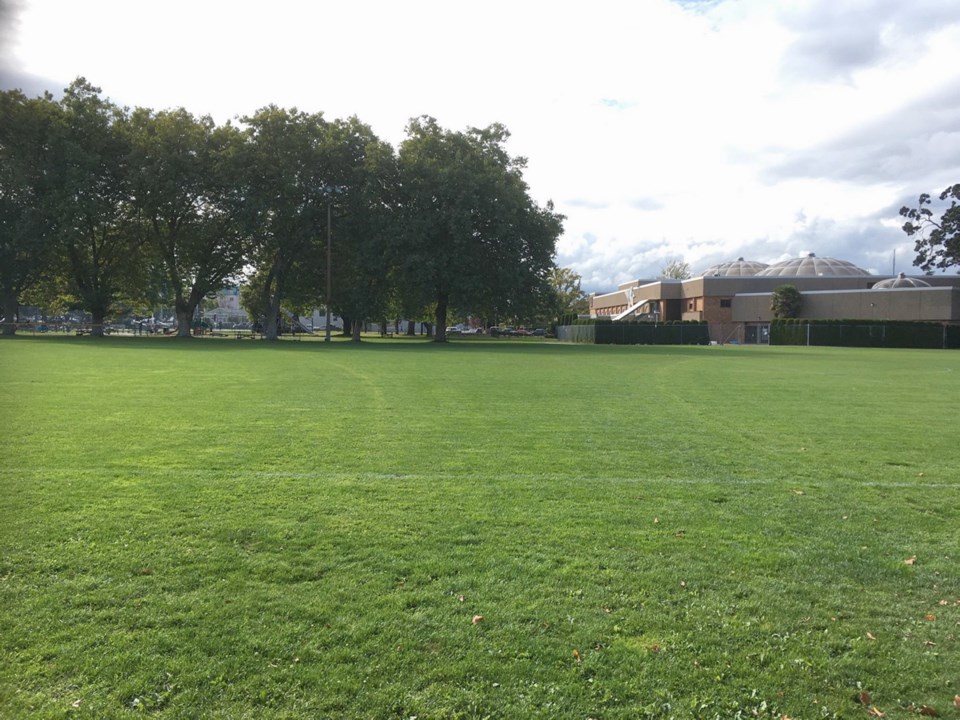A commentary by the managing director of the Canadian Urban Sustainability Practitioners. She is also a board member of the North Park Neighbourhood Association and the City of Victoria’s former senior planner of environmental issues.
For two years, the associations covering the northern neighbourhoods of North Park, Downtown/Harris Green and Hillside Quadra have been unified in calling for Victoria’s most significant investment in social infrastructure — the new $80-million-plus Crystal Pool — to move ahead swiftly.
The associations also want the project to capture as many opportunities for impact and equitable well-being as possible.
We have been consistent in our calls to retain the green space in Central Park and assets such as the Steve Nash basketball court and playground, which were intentionally located in the sunny corner of the park.
We have asked that the project be built in one of the large city-owned parking lots that blight this area, recently referred by some profiteers as the “Stadium District.” The thousands of us who live here refer to it as the place we raise our kids, participate in community life and where we proudly, but often barely, afford to live.
We have asked that the project include much-needed affordable child-care spaces, a community kitchen and a full-size indoor gymnasium. Those pleas have been echoed through many letters to mayor and council over the years.
A single-purpose aquatic centre does not provide the variety of out-of-water and non-sport recreation and community needs required of Victoria’s single recreation centre, situated adjacent to the commercial core and in growing neighbourhoods that do not have community centres. These centres provide 80 per cent of all child-care spaces in Victoria.
The downtown and north end is accommodating the lion’s share of Victoria’s current and future population growth and development, yard-less high-density housing (57 per cent of the 2016 population lived in apartment buildings of more than five storeys), and an official community plan that denotes the north end of downtown and Harris Green as park deficient, based on 2012 population.
We can’t afford to lose any green space; we must look at every opportunity to reclaim, not just retain, green space when opportunities arise.
With the imminent departure of the Y from Victoria, the children, families and seniors of low income that benefit from their affordable and varied recreation and services, will need a replacement for the mental and physical health, inclusion and belonging that the Y provides.
With increasing disparities and inequality, a housing crisis and climate emergency, we must not squander opportunities to address current and future gaps in infrastructure and services needed by local residents and businesses.
Our decisions and the design of the city, its public assets and spaces, must not further exacerbate issues affecting well-being and livability for all.
Equity is about just and fair inclusion into a society in which all can participate, prosper and reach their full potential.
Improving the lives and equitable well-being of those in our community, a growing number of which are in Victoria’s northern neighbourhoods, is not a zero-sum game for those in the rest of the city or the region.
The region’s swim clubs don’t have to lose for northern neighbourhoods and the city’s most under-served to win.
The disparities between homeowners and renters, established residents/users and newcomers, entitled special interest groups and marginalized voices, are becoming too great.
We need to embrace the notion that we are all in this together. Moreover, we need to look beyond ourselves and the current day to the effects our decisions and investments in the city will have. What ills are we creating, and what will we leave for future generations?
Equity looks at the outcomes we want for people and it backs into what the inputs need to be. When we create a space in which everyone is able to reach their full potential, we are actively pushing against the extraordinary disparities growing in this city and others like it.
A recent letter to the editor implied that board members from three neighbourhood associations do not accurately represent their members. That is not correct.
The North Park, Hillside-Quadra and Downtown neighbourhood associations base decisions and recommendations on feedback from residents collected through emails, surveys, door-knocking, community events, petitions and in-person attendance at meetings.
Board representatives are voted into position by their members — the neighbourhood’s residents and businesses.
> More info on equity-related opportunities and the Crystal Pool at crystalpoolforall.com



